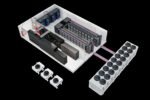Data is of prime importance regardless of whether you are doing business online, delivering better patient care, sequencing the next discovery, delivering your software via SaaS, or evolving your business analytics to real time. The increasing adoption of IoT and digital transformation has given rise to a seemingly interminable production of data.
As data keeps growing exponentially, the requirement for faster and cost effective storage solutions will also grow with it. Unsurprisingly, enterprise storage is seeing plenty of innovation and is slowly demanding its due attention, thanks to increased adoption of flash and hybrid arrays, and cloud storage options. This is evident from IDC’s recent market report that suggested a modest growth in the overall enterprise storage market in the second quarter of 2017.

Advances in data storage are happening rapidly but not without challenges. On one hand there exists a demand for the latest storage products while on the other there remains the need to stay connected to legacy systems that are still being used by many to run critical applications. Lenovo DCG acknowledges the need for ultimate data solutions and has a rich portfolio with clear direction for the future of data centres. The company offers products to serve the traditional data centre, as well as hyperconverged and software defined storage infrastructures.
With a number of storage options are available to address different application workloads and business needs, the trick lies in how organisations transition from legacy storage as those products reach end-of-life. So what are the leading innovations in storage industry? Many industry analysts forecast that NVMe, is enabling the next generation of flash performance and density causing it to become the leading interface protocol for flash by 2019.

Anand Chakravarthi, Area Vice President, Pivot3 supports this notion and adds, “The big one is non-volatile memory express, or NVMe which is fast becoming the protocol of choice and will replace SCSI, with most of the market pivoting to end-to-end NVMe-based systems. Pivot3 helps its customers deal with this transition in that it easily integrates with legacy IT systems to get the most out of their existing investments.”
A critical mass of consumer devices has already shifted to NVMe, and the enterprise will not be far behind. NVMe will bring many benefits to customers’ applications and data centres including better performance, higher density, performance density, larger and larger flash modules and greater consolidation.

Christian Putz, Director, Emerging Markets EMEA, Pure Storage agrees with Chakravarthi in terms of where the future of storage is headed and adds that NVMe is poised to drive a shift across the storage industry to NVMe architectures. “At Pure, we are already ahead of the curve and have engineered our solutions to be NVMe ready,” explains Putz.
Talking about the technology innovations that will impact storage industry, Khwaja Saifuddin, Senior Director – Sales MEA & SE Asia, Western Digital adds that it is MAMR technology (microwave-assisted magnetic recording) that will pave the way to higher recording densities and lower the cost per terabyte of hard disk drives for not just video surveillance systems and consumer NAS products but also for enterprise data centres.

“To meet the future demands of Big Data with proven data centre-level reliability we have announced our breakthrough innovation, MAMR. Using this technology we can deliver capacities of 40TB on a single Hard Disk Drive,” explains Saifuddin.
Having recently entered the storage market, the Business Development Manager, Storage Business MENA, Lenovo DCG, Mohammad Al Mufleh feels that this only gives the company an added advantage to be able to operate like a start-up as we don’t have legacy product lines or acquired legacy portfolios to protect.

“Organisations need to decide if they want the new capabilities around management, orchestration, solid state, hybrid, converged and more options. Each capability has to align with an organisation’s goals and requirements. To manage a transition, one principal rules above all: portability. Data and workloads need to be portable and abstracted to keep agility high,” states Rick Vanover, Director of Technical Product Marketing & Evangelism, Veeam Software.
In such a challenging scenario, there are still a number of opportunities available for partners that can add value and deliver solutions and services to customers. As an example, entry to mid-level SAN market remains the largest growing market today. This is why Lenovo DCG offers an abundance of information, support and training to its channel and business partners to help educate them on the enterprise storage offerings and market segments.

However, in this brave new world of big data analytics and machine learning, IoT and edge computing services, powerful container-based development platforms, new database services and advanced SaaS apps, it is not possible to have a ‘one-size fits all’ approach to storage.
Jithin Varghese, Storage Solutions Architect, VAD Technologies adds that organisations need to predict their data growth and accordingly build a long-term strategy. “Whether they have a cloud- or on-premise model, they need to ensure that they employ bi-directional data migration solutions.”
It is clear that IT has more options than ever to customize solutions to business needs and thus numerous opportunities exist in terms of strategic partnerships that can link these rapidly developing capabilities with different platforms like hyperconverged infrastructure, etc. So, data is where the potential lies, yet we are just at the beginning of leveraging machine learning and advanced analytics and there still remains a lot to explore.











